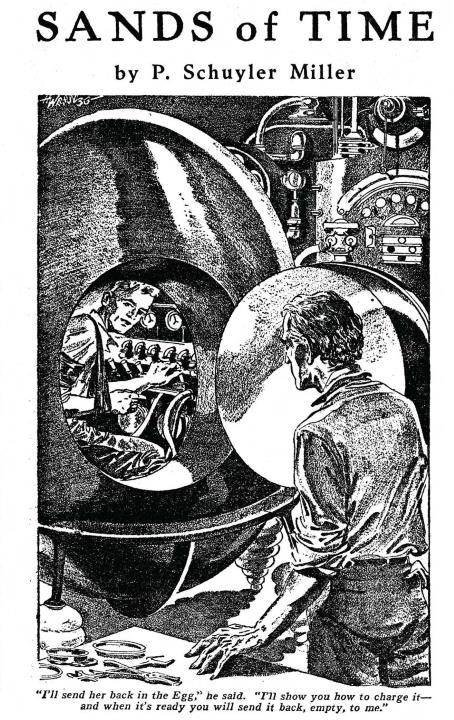The Sands of Time
- by P. Schuyler Miller
- Novella
- Science Fiction
- Adults
- Definite Time Travel
- English
- “Sands of Time” by P. Schuyler Miller, in Astounding Stories, April 1937.
Terry Donovan realizes that it’s possible to travel through time in 60,000,000-year increments, so naturally he travels back to the Cretaceous where he meets dinosaurs and aliens.
This story was under Tremaine’s Astounding editorship, but the sequel, “Coils of Time,” (May 1939) appeared after Campbell became editor.
This story was under Tremaine’s Astounding editorship, but the sequel, “Coils of Time,” (May 1939) appeared after Campbell became editor.
—Michael Main
Incidentally, I have forgotten the most important thing of all. Remember that Donovan’s dominating idea was to prove to me, and to the world, that he had been in the Cretaceous and hobnobbed with its flora and fauna. He was a physicist by inclination, and had the physicist’s flair for ingenious proofs. Before leaving, he loaded a lead cube with three quartz quills of pure radium chloride that he had been using in a previous experiment, and locked the whole thing up in a steel box.

Tags
(9)
- Time Periods
- Age of Reptiles (252 Ma to 66 Ma: Mesozoic/Triassic/Jurassic/Cretaceous): described as being in the Cretaceous, roughly 60 Ma
- Circa AD 1930 to 1939: The year 1937 is specified in the sequel as the time of this story.
- Time Travel Methods
- Time Spheres, Eggs, et al.: The Egg: a chamber barely large enough to hold a man, with a host of dials and switches [. . .]
- Themes
- Adjacent Times: “Time is coiled like a spring. Some other age in earth’s history lies next to ours, separated only by an intangible boundary, a focus of forces that keeps us from seeing into it and falling into it.”
- Real-World Tags
- Archaeologists and Paleontologists: Professor E. J. Belden
- Dinosaurs
- Groupings
Variants
(2)
- “Sands of Time” by P. Schuyler Miller, in Astounding Stories, April 1937.
- alternative title.“The Sands of Time” by P. Schuyler Miller, in Adventures in Time and Space, edited by Raymond J. Healy and J. Francis McComas (Random House, 1946).
Translations
(2)
- German.
“Spuren im Sand der Zeit” [Traces in the sands of time] by P. Schuyler Miller, in Die Mörder Mohammeds, edited by Robert Silverberg (Marion von Schröder, 1970). - Portuguese.
“As Areias do Tempo” [The sands of time] by P. Schuyler Miller, in Viajantes no Tempo, edited by Robert Silverberg (Galeria Panorama, 1967).
